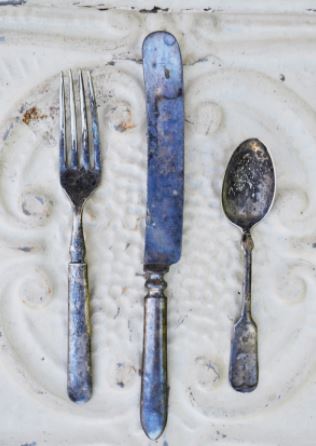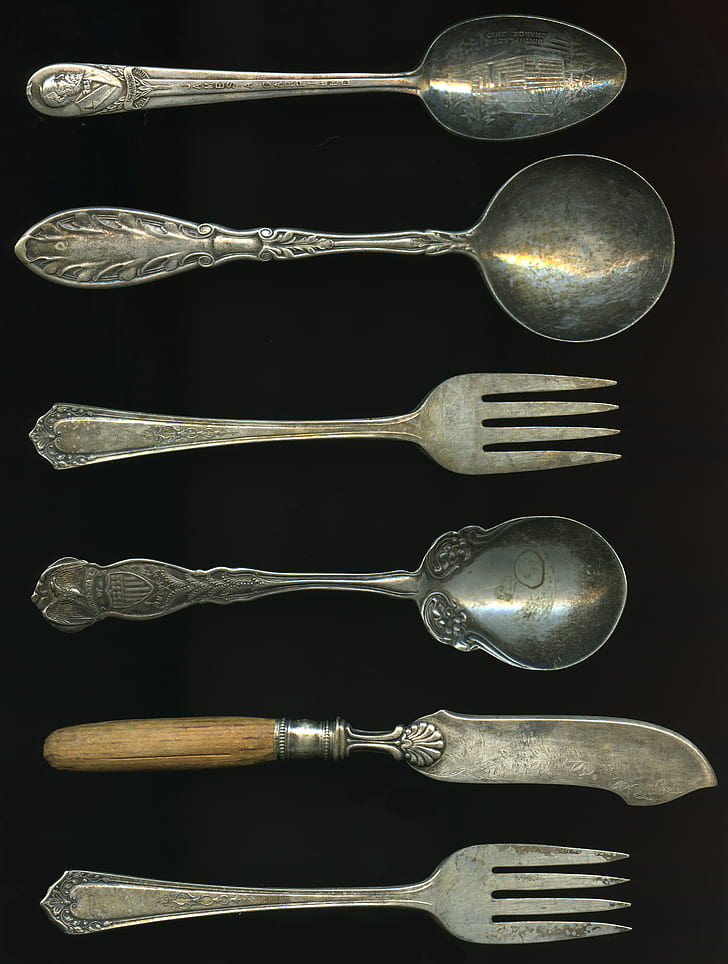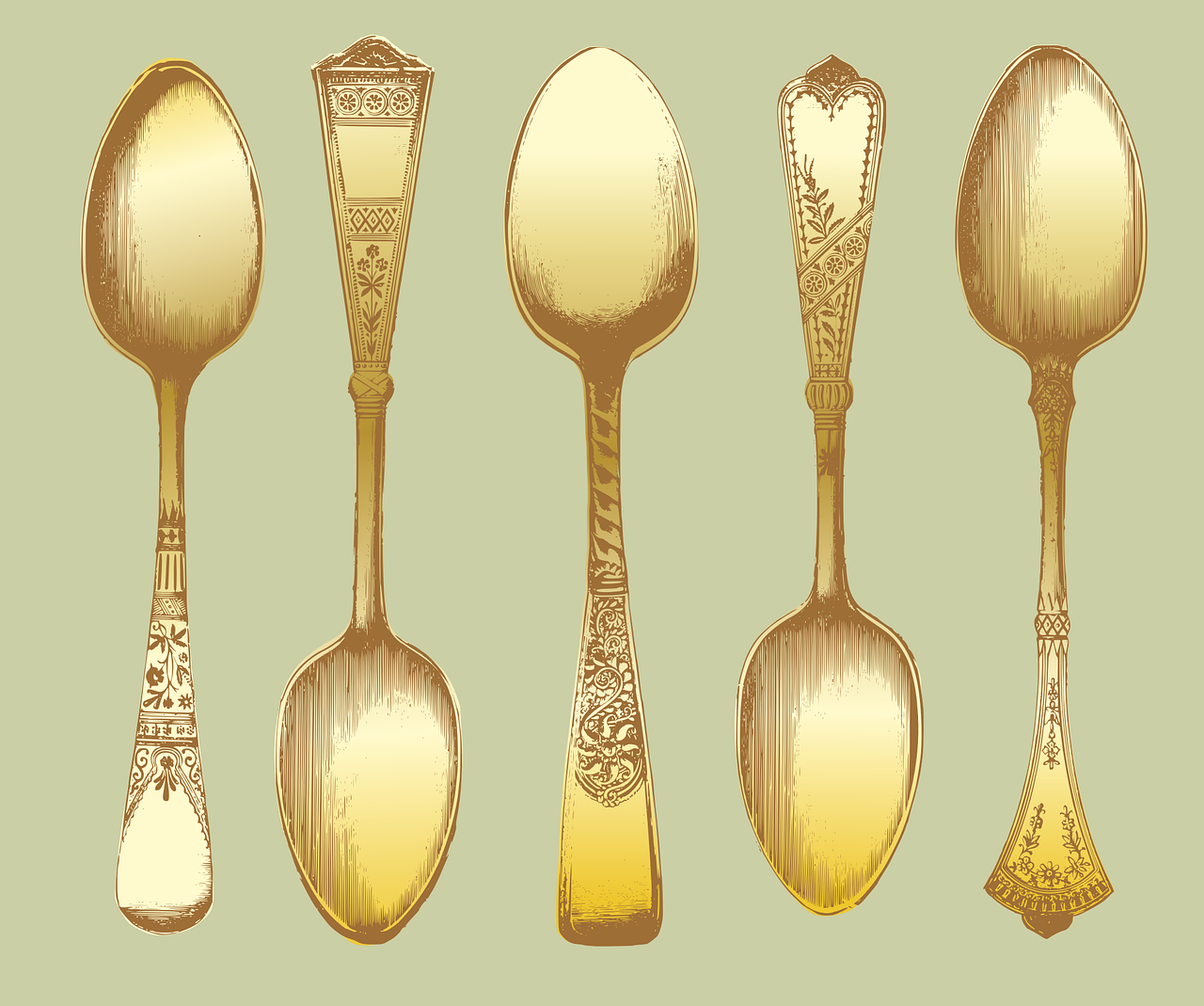How Does Our Metal Cutlery Affect Taste?
Last week I talked about the interesting history behind forks, knives and spoons and how it actually transformed the way our mouths are formed. I wanted to delve in just a bit more this week and talk about if the metals we use for cutlery actually change the taste of what we eat.

This once again stems from listening to the Gastropod podcast by hosts Nicola Twilley and Cynthia Graber, which is a really excellent podcast I highly recommend.
Before stainless steel cutlery, which is the norm that people almost exclusively use today, people actually used to use plain steel--which is made up of iron with a little bit of carbon. It is strong and it can be sharpened, but when it comes into contact with anything acidic (lemon, vinegar, tomato, etc.), the iron reacts--the metal turns black and the food it touches tastes really gross.
On the other hand, stainless steel has a little bit of chromium in it, which is a game-changer. Originally they were testing out stainless steel for military uses like yachts or gun barrels at the beginning of the 20th century when they realized that this was a great metal and a way they could get non-corrosive cutlery to the masses. At that time, if you wanted non-corrosive cutlery your only choice was silver, which was very expensive.
This is where fish knives came from. Back then, people would save up money for just the one knife made out of silver to be able to eat the fish with lemon and not have the utensil corrode and negatively change the flavor entirely. If you were lucky you might have the one good silver fish knife and the rest of your cutlery would have been steel.

Silver cutlery was (and still is) expensive and is also quite high maintenance to take care of it so it does not tarnish. Thankfully, they started using stainless steel, which was a clear winner for everyday use that everyone could afford. Even though we are all very used to stainless steel and wouldn’t probably give too much thought to using anything else, are there other metals that could make our food taste even better?
A researcher based out of London named Zoe Laughlin--co-founder of the Institute of Making at University College in London--wondered this very question. She set out to test out different metals for cutlery and see which one would really reign supreme above all others. The only tests that had really been done on how metal affects taste were from researchers that had people swish metal salts around their mouth. This is far different than if you use a spoon to eat a bite of tomato soup.
So Zoe had 6 different spoons made of 6 different materials that are of equal size, weight, and shape--copper, gold, silver, tin, zinc, chrome and stainless steel--and she got a group of volunteers to test out of the different materials. First, she had them just suck on the spoon by itself for a few seconds and record what they thought. Next, she dipped the spoon in cream and had them taste it and record their thoughts. She concluded that different metals really do make our foods taste different because the atomic properties of each metal affects the way the utensil reacts with our saliva--so, for example, copper is more bitter than stainless steel.
Zoe also took it one step further and decided to hold a taste test and invited media members and fellow researchers to a party where they could try different dishes and they discovered fun things like how delicious lamb with pistachio is on a tin spoon. The one that stood out the most was definitely the gold. She said that you have never tried mango sorbet until you have tasted it from a gold spoon.

While we don’t all have access to hold this elaborate taste test at home, you can still experiment with what you have at home. You could make a couple dishes, perhaps something acidic like a pasta with tomato sauce, and something sweet like sorbet for dessert--use your stainless steel spoon, a plastic spoon, and a wooden spoon. Each will give you a slightly different taste and you could really have a fun experiment with your kids or grandkids doing this.

Now I feel like I’ve got to find a way to save up and get my hands on some gold plated cutlery. Do you happen to own a set of pure silver cutlery? Can you confirm that it makes things taste different than on your usual stainless steel? Please share your thoughts in the comments below.
Sources:
Zoe Laughlin’s scientific papers on the taste of metals:
The use of standard electrode potentials to predict the taste of solid metals, Zoe Laughlin, Martin Conreen, Harry J. Witchel, and Mark Miodownik, Food Quality and Preference, Volume 22, Issue 7, October 2011, Pages 628-637.
Tasting spoons: Assessing how the material of a spoon affects the taste of the food, Betina Piqueras-Fiszman, Zoe Laughlin, Mark Miodownik, and Charles Spence, Food Quality and Preference, Volume 24, Issue 1, April 2012, Pages 24-29.
This once again stems from listening to the Gastropod podcast by hosts Nicola Twilley and Cynthia Graber, which is a really excellent podcast I highly recommend.
Before stainless steel cutlery, which is the norm that people almost exclusively use today, people actually used to use plain steel--which is made up of iron with a little bit of carbon. It is strong and it can be sharpened, but when it comes into contact with anything acidic (lemon, vinegar, tomato, etc.), the iron reacts--the metal turns black and the food it touches tastes really gross.
On the other hand, stainless steel has a little bit of chromium in it, which is a game-changer. Originally they were testing out stainless steel for military uses like yachts or gun barrels at the beginning of the 20th century when they realized that this was a great metal and a way they could get non-corrosive cutlery to the masses. At that time, if you wanted non-corrosive cutlery your only choice was silver, which was very expensive.
This is where fish knives came from. Back then, people would save up money for just the one knife made out of silver to be able to eat the fish with lemon and not have the utensil corrode and negatively change the flavor entirely. If you were lucky you might have the one good silver fish knife and the rest of your cutlery would have been steel.

Silver cutlery was (and still is) expensive and is also quite high maintenance to take care of it so it does not tarnish. Thankfully, they started using stainless steel, which was a clear winner for everyday use that everyone could afford. Even though we are all very used to stainless steel and wouldn’t probably give too much thought to using anything else, are there other metals that could make our food taste even better?
A researcher based out of London named Zoe Laughlin--co-founder of the Institute of Making at University College in London--wondered this very question. She set out to test out different metals for cutlery and see which one would really reign supreme above all others. The only tests that had really been done on how metal affects taste were from researchers that had people swish metal salts around their mouth. This is far different than if you use a spoon to eat a bite of tomato soup.
So Zoe had 6 different spoons made of 6 different materials that are of equal size, weight, and shape--copper, gold, silver, tin, zinc, chrome and stainless steel--and she got a group of volunteers to test out of the different materials. First, she had them just suck on the spoon by itself for a few seconds and record what they thought. Next, she dipped the spoon in cream and had them taste it and record their thoughts. She concluded that different metals really do make our foods taste different because the atomic properties of each metal affects the way the utensil reacts with our saliva--so, for example, copper is more bitter than stainless steel.
Zoe also took it one step further and decided to hold a taste test and invited media members and fellow researchers to a party where they could try different dishes and they discovered fun things like how delicious lamb with pistachio is on a tin spoon. The one that stood out the most was definitely the gold. She said that you have never tried mango sorbet until you have tasted it from a gold spoon.

While we don’t all have access to hold this elaborate taste test at home, you can still experiment with what you have at home. You could make a couple dishes, perhaps something acidic like a pasta with tomato sauce, and something sweet like sorbet for dessert--use your stainless steel spoon, a plastic spoon, and a wooden spoon. Each will give you a slightly different taste and you could really have a fun experiment with your kids or grandkids doing this.

Now I feel like I’ve got to find a way to save up and get my hands on some gold plated cutlery. Do you happen to own a set of pure silver cutlery? Can you confirm that it makes things taste different than on your usual stainless steel? Please share your thoughts in the comments below.
Sources:
Zoe Laughlin’s scientific papers on the taste of metals:
The use of standard electrode potentials to predict the taste of solid metals, Zoe Laughlin, Martin Conreen, Harry J. Witchel, and Mark Miodownik, Food Quality and Preference, Volume 22, Issue 7, October 2011, Pages 628-637.
Tasting spoons: Assessing how the material of a spoon affects the taste of the food, Betina Piqueras-Fiszman, Zoe Laughlin, Mark Miodownik, and Charles Spence, Food Quality and Preference, Volume 24, Issue 1, April 2012, Pages 24-29.
Sources:
- www.antiquesilver.org
- www.pxhere.com
- www.gastropod.com
- www.pixabay.com
 Mary Richardson
Mary Richardson
Weekly Newsletter Contributor since 2014
Email the author! mary@dvo.com
